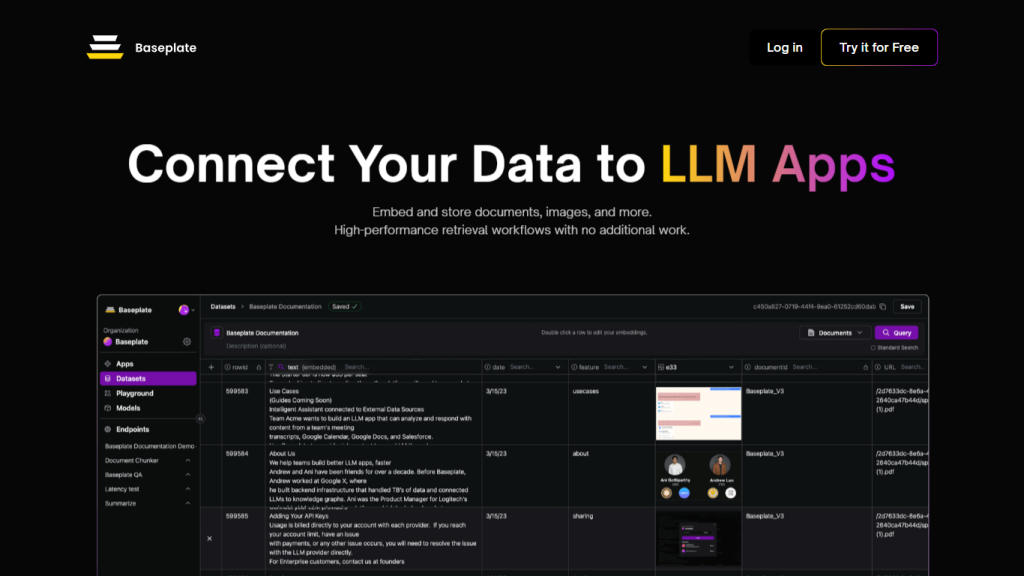What is Baseplate?
Baseplate is a multifaceted tool that lets users embed and store various kinds of data, such as documents and images, in one table. Consequently, it makes lives easier by managing data to provide high-performance workflows for data retrieval without extra effort. It connects your data through UI or API and makes embedding, storing, and version control of your data easy. Rest assured, your data will stay up-to-date. Be it setting up hybrid search using custom embeddings or prompting any Language Model with your database data, Baseplate provides the necessary tooling to make developing AI apps a cakewalk.
Key Features & Benefits of Baseplate
Embedding and Storage:
Documents, images, and more can all be embedded and stored in one table, removing the hassle of needing separate storage solutions for data.
Version Control:
It automatically versions everything to keep all the data current and devoid of any duplicates so you have the latest available information.
Hybrid Search:
The hybrid search functionality it presents is with custom embeddings wherein the setting is regarding the data. It shows very accurate search results, be it another data type, size, or domain.
Application Builder Integration:
The baseplate can work in good harmony with App Builder, allowing one to trigger any language model with information from the database to make the AI application functional and friendly.
Easy Deployment:
The deployment of an AI application takes a couple of clicks to bring it online and start gathering data inside the Baseplate endpoints.
Use Cases and Applications of Baseplate
Baseplate finds application in the following cases and industries:
-
Enterprise Information Management:
Baseplate can also be utilized in handling large volumes of documents and images for organizations, where storage and retrieval are effectively carried out. -
AI App Development:
Baseplate is useful in embedding and storing data frictionlessly to make advanced AI application development easier for developers. -
Research and Academia:
Researchers can utilize Baseplate in storing and retrieving data on research papers, images, and other academic materials. -
E-commerce:
E-commerce websites can leverage Baseplate’s hybrid search for better product finding and recommendation systems.
Several companies have already put Baseplate to work, which would seem to be proof of its functionality in regard to data administration and retrieval.
How to Use Baseplate
Using Baseplate is very straightforward:
-
Connect Your Data:
Ingest your data into Baseplate via UI or API. -
Embed and Store:
Embed your various types of data into one table so that all your data lives in a single location. -
Version Control:
You don’t have to do anything; Baseplate can manage the version control for you and keep your data updated without any duplicate form. -
Hybrid Search:
Implement hybrid search with custom embeddings to look for data with high accuracy and speed. -
Deploy Your App:
Publish your AI app in just a few clicks and start collecting data through the endpoints that exist on Baseplate.
For Optimum Performance
It is suggested to pre-embed organize your data for optimum performance. Make use of the version control on Baseplate so that no data should be duplicated.
Baseplate How It Works
Baseplate works by embedding data in one table and storing it with advanced algorithms that provide for its efficient retrieval. It is integrated with App Builder, which allows the developer to interface Language Models seamlessly with the database data. Just connect your data, embed, and version control to keep it updated. Hybrid search capabilities allow for the precise retrieval of data, making Baseplate indispensable in AI app development.
Pros and Cons of Baseplate
Like any other tool, Baseplate has a few pros and cons:
Pros
- Seamless embedding and storing data
- Versioning is done automatically
- Hybrid search highly accurate
- Integration with App Builder is seamless and easy
- Easy deployment
Cons
- Data organization takes time for the initial setup
- Only data types and sizes work best
Users reported positive feedback and the ease of use, and effectiveness of Baseplate. This resulted in a better user experience.
Baseplate Conclusion
In a nutshell, Baseplate is a powerful tool for data embedding and storage that boasts among its features version control, hybrid search, and ease of deployment. With its perfect blend of seamless integration with App Builder and an intuitive interface, AI app developers and organizations dealing with large volumes of data can safely consider it nothing short of the best. Baseplate is both reachable and worth it through its freemium pricing model. The potential of this tool to ease data management makes it worth an investment by anyone. Updates in the future and developments further promise to make the tool more capable and rounded within the top echelons of tools in the AI space.
Baseplate FAQs
-
What kind of data can I embed with Baseplate?
Baseplate supports many kinds of data, including documents and images, for complete data management. -
Does Baseplate handle versioning?
Baseplate automatically versions your data, and you can rest assured that the latest information about something exists and no duplicates exist. -
Can I do hybrid search with Baseplate?
Yes, Baseplate supports hybrid search with custom embeddings particular to your data for accurate and fast searches. -
Is model deployment easy on Baseplate?
Deploying your AI application is quite easy on Baseplate and requires just a few clicks to get up and running. -
How much does Baseplate cost?
Baseplate offers a freemium pricing plan. The basic features are free but can be upgraded for more features.










